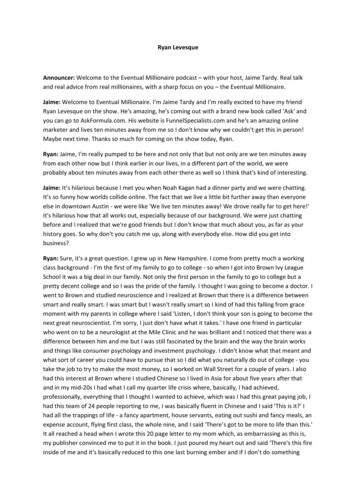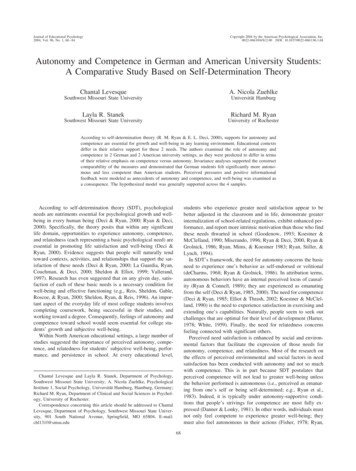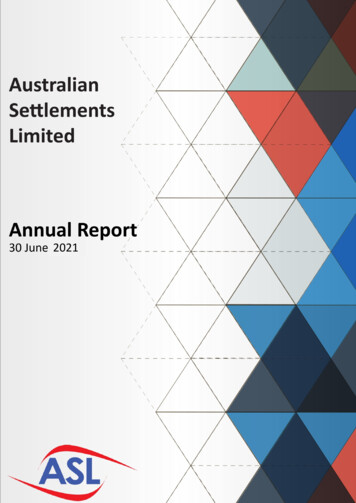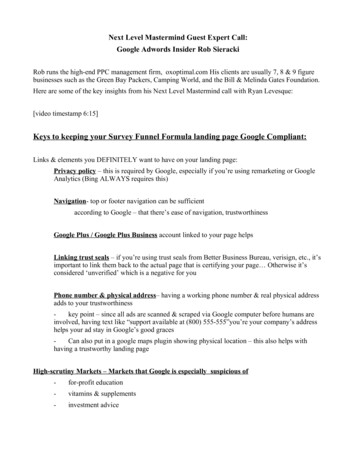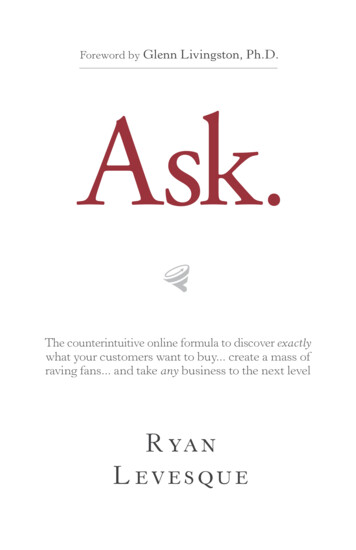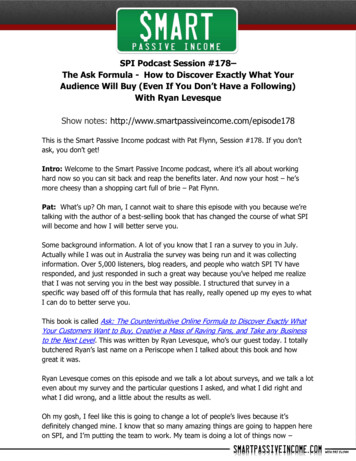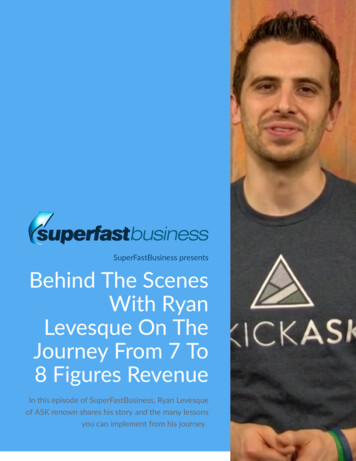
Transcription
SuperFastBusiness presentsBehind The ScenesWith RyanLevesque On TheJourney From 7 To8 Figures RevenueIn this episode of SuperFastBusiness, Ryan Levesqueof ASK renown shares his story and the many lessonsyou can implement from his journey.
Behind The Scenes With RyanLevesque On The JourneyFrom 7 To 8 Figures Revenueby SuperFastBusinessRyan LevesqueJames: James Schramko here, welcome back to SuperFastBusiness.com. And I’mreally excited about today’s episode because we’re going to go on a journey and togo on this journey I have brought back a friend of mine and someone who I’velearned plenty from and who has also learnt some things from me. Welcome, RyanLevesque.Ryan: James, it’s awesome to be back here. Really grateful and happy to be chatting
again.James: I love it when we do catch up, because we always exchange some greatideas. And I’ve been tracking your journey, well, from I guess around the time youwere doing close to a million dollars a year to now. Or even a year ago, you were ontrack or very close to around the 10-million-per-year mark. So what that’sprovided for me has been a great insight into some of the changes that happen as abusiness grows and as a brand develops. And I invited you to come along and talkabout that, because I think that’s very instructive for other people who listen to thisshow. And so upfront, I want to say thanks for your impending generosity.Ryan: Well, you know, listen, I’m really grateful. You have been one of the mostinstrumental or impactful mentors that I’ve had in that process. I still remember thefirst time when you and I had our first call together and we were introduced by amutual friend. And gosh, I think it was, you know, the program I had signed up forwas like a 30-minute welcome call or something like that. And you just keptlistening to me for like two hours on that first call. Just me, like, rambling with allthe thoughts going on. And that was the start of a really specialrelationship that you were super, like I said, impactful and instrumental in helpingme in this journey. So it’s just cool to be able to share it with you and kind of talk alittle bit about how things have changed inside.James: Yeah, well, thank you. And isn’t it interesting as part of the process fordiagnosing and solving the challenge in the marketplace? It is good to just listen atthe beginning and calibrate to your customer. It’s pretty much what you teach withthe ASK Method, right? Is to find out stuff before you launch in there with thesolutions. So, it’s definitely been a part of my process coming from a salesenvironment where a lot of people were pushing solutions. And then I found abetter technique was more of a consultative or diagnostic approach.Now, what I admire about what you’ve done is you’ve learnt this technique fromsomebody else and you studied this person very closely with their permission, andyou really made that idea into what it is now, which is sort of a combination Your portfolio, if I’m correct, is you’ve got your own products that you’re sellingusing your method; you’ve got software that supports your method; you’ve gotinformation products around your method, and you’ve really taken that method onwell past the stage that you’d learnt it. So you’ve actually developed it into more of
a movement, I suppose, where you’ve got people in most major cities applying thisto most different markets. Is that an accurate depiction of where we’re at?Everything is a remixRyan: Yeah, I mean, that’s pretty accurate. So the person you’re mentioning, mymentor, one of my first mentors in business, Dr. Glenn Livingston, he was the firstperson that I really learned a lot of the methodology from.And I think it’s true of all of us, like, right? We all have mentors, people that we’veeither learned from on like, a personal basis, like you actually really know theperson, and then people that we’ve learned from from afar, through the books thatwe’ve read, the courses that we’ve studied and things like that. And you see this inevery discipline, right? From science to technology to arts, everything is built uponthe previous generation’s ideas and thoughts.And so I think it’s, number one, it’s irresponsible and it’s also inaccurate to misleadpeople into thinking that whatever brilliant idea you’ve had, or success that you’vehad is your own doing. It’s the sum total of everyone who came before you whoblazed the trail, who created the path, and then whose discoveries and ideas led towhat it is that you’ve created.So, yeah, I think that’s 100% accurate. And I’d say, I mentioned you, I mentionedGlenn, I think a lot of people have had a big impact in my life to help make thatpossible.
James: You know, you’ve been excellent at assimilating information from peopleand turning that into your own thing with a unique sort of branding or personality.There is a great video, I’ll link to it from the show notes, I think it’s called Everythingis a Remix, but it’s pretty cool and you certainly can learn things from the musicindustry like the four chords that pretty much drive almost every song.The drive behind the 8-figure revenueThe way that you’ve done it is excellent, and one thing that struck me when I wascoaching you is how driven you are. You have this inner fire. You’ve got a deadlycombination of technical understanding, which some people call geeky, but you’vegot technical capacity. But you also have a very strong determination and resolve.Did you always know that you wanted a 10-million-per-year-revenue business?Ryan: Oh it’s so funny, you know, it’s total opposite. When I first got into this world,right? The world that we’re in is the online business world, selling training andInformation programs and things like that Like you, I was in a corporate job, Iworked for a big company. I didn’t even know that this world existed. And my biggoal at the time was I said, if I could make 10,000 a month in passive income,where I didn’t have to show up to an office, it’s just money that came in, you know,while you sleep, so to speak, why would I want to work another day in my life? Thatwas it. That was the sum total. I was like, if I could get there, I’d be done. I’ll retire,I’ll be 25 years old, 28 years old, whatever I was at the time. I’ll retire, I’ll neverwork another day in my life, and I’ll just live on that 10,000 a month.And what ends up happening, and I don’t know if this is true for everybody, for mecertainly, it’s that 10,000 a month, you hit it and it’s like, okay, great. Now it’s 20,000 a month, and then it’s a million dollars a year. I remember the day thatTylene and I, we had our first million-dollar day, like literally did a million dollars ofsales in a single day. Not to make people think like that happens every day. Thatwas a very special day, like a once-a-year type thing. But we did a million dollars ina single day and, you know, our life didn’t change. We gave each other a hug andsaid, “Alright, what’s next?”A mentor of mine likes to say, “New level, new devil.” And really what that means is,you get to a new level and there’s always something that rises and there’s alwayssomething that’s moving ahead. So for me, yeah, I think I’m pretty intrinsicallydriven, just very self-competitive.
My thing that I’ve realized, and I think this is true for people who resonate withwhat I teach, is there are a lot of, I think, experts or educators out there who createsort of freedom as the as the ultimate goal. I know it’s a big part of your life, right?Having the freedom to be able to go surfing and live that life and have everything.And I think freedom’s super important. For me, what I’ve realized, the drug that ismore powerful than freedom, for me, is momentum. When I have momentum in mylife, when I feel like I’m moving forward, when I feel like the accelerator is pushingme forward, I feel like I could take over the world. It feels like it’s the most amazingfeeling in the world. Freedom for me is fleeting, like it comes and it goes. Like, I’llhave moments of freedom. But if I have constant momentum, constant progress,constant moving forward, like, that drug makes me feel better than anything else.And so I seek that out. I seek out, OK, where am I going to get momentum? And itcan be in different dimensions. It doesn’t have to just be in business, it can be inhealth and fitness and things like that. But I realized I need that in my life to feelfulfilled, like I’m making progress and have momentum in whatever challenges I’mtrying to solve.James: Yeah, I think it’s that drug that makes you send so many emails in a singleday. I’ve worked with quite a lot of people, and I do see it. You are like, and that’slike, in a nice way, but you’re like, a very driven person and I think it causes you tooperate, to get that release, to get that feeling. And you said it so well, actually. Ilike that saying, “New level, new devil.”The 10 million revenue is a very common stated goal for people when I start mydiagnostic at high-level coaching, especially seven-figure entrepreneurs. And I doquestion that. Why? Why is this important? What will change in your life when yougo to 10 million a year in revenue from 4 million a year in revenue? Becausemost business owners are making at least a million dollars’ profit, even at 4 milliona year revenue. So there has to be something else.And you know, you found your one, and I imagine it probably also ties into yourhobby of LEGO. Hopefully I pronounce that correctly.Ryan: You nailed it.James: I wouldn’t put an on it or stick it into lower case or anything. Maybe you liketo build and create and imagine different ways that things can be rearranged and it
sort of flows through into your work.When you don’t want to do stuffSo a little bit tongue in cheek there, but I wanted to know, do you have to do thingsin business that feel uncomfortable to you at times? For me as a business owner, Idon’t get as caught up in the competitiveness of, say, product launches. That’s adeterrent for me, because it doesn’t feel right. But for you on your drive, and withthe peer group and the company that you keep, that’s more the norm. Do youenjoy those things, or are there things that you do that you don’t love from time totime?Ryan: Yeah. I mean, I think, gosh, I wish I could say, “Listen, you’re the boss, you getto call the shots, you can make your own rules.” And to some extent that’s true,right? And of course, you can get to a point where you’re just going to say, “Youknow what? I’m not going to do this anymore. I’m going to make my own rules.” Butwhen you do that, there are consequences, right?You know, small examples, I see people who, you know, say, “I’m going to shunsocial media. I’m off Facebook. I’m going to leave Facebook.” And more cases thannot, I can’t tell you how many people that have come through that circle in my lifethat they leave Facebook, they’re not going to be on there, and then a year laterthey’re back, right? Because that’s where the rest of the world is. And so yeah,there’s a price associated with it. You’re going to lose contact with all human beingsthat you know. And so if you’re prepared to do that, fine, but sometimes it’s notwhat you might think it might be.James: What is it, the grass on the other side still needs mowing?Ryan: Yeah, exactly. Yeah, for sure. And so a couple of examples. Do I wish wecould send one email out and everybody would come flooding to do the thing andbuy the thing and do whatever we’re encouraging people to do? Of course! Ofcourse I’d love to be able to do that. But what I’ve also learned is, if we just did afour-day holiday sale, every email that we sent out generated an additional, I don’tknow, 40, 50,000 in revenue, right?
So you’ll have critics that will say, oh, you’re sending out too many emails. But thenon the flip side of it, what I’ve learned to believe in is, listen, if you believe in yourproducts, you believe in what it is that you’re selling, you have a duty, you have aresponsibility to get that into the hands of other people.Because here’s the deal. There’s someone out there that didn’t check their email intime and they’re not going to get access to the product. They’re going to go tosome second-class expert who doesn’t know what the hell they’re talking about.They’re going to follow sh**, crappy advice. (Excuse me.) They’re going to followcrappy advice, and they’re going to spin their wheels for another six months.I can’t tell you how many people come in my world and they say, “Ryan, do youknow how much money I’ve invested in programs, and how much I wish I wouldhave found what it is that you’re teaching like, five years ago?” So when you hearstories like that, and I’m sure you hear it all the time, people who come to you andthey’re like, ‘Gosh, James, everything that you say makes sense. Like, you’re tellingthe truth. I believe you. Thank you so much for everything that you do. I wish Iwould have found you three years ago, because I just had all this pain and sufferingand struggle and money wasted,” and everything like that.So there’s a flip side to every coin. Because I get it. I get what the critics might say,you know, I’m pushing too hard, marketing too hard. But on the other side, there’sanother side to that story.James: Yeah, I think it’s a good one. I actually made a video about this. You’ll laughat this one, but I made a video talking about people’s reluctance to send an email totheir customer base. And I think, here’s my major point on this. It really has to come
around to context. Did people ask to be communicated with, and is it relevant towhat they’ve asked for? And that’s, you know, it’s super ironic because of what youdo.One of my customers sent out an email to his customers. He sent four emails overfive or six days and got 66 new members to his membership, because the peopleon his email list had not been hearing from him, and they wanted to hear from him.And the difference there is, I know there’s people who believe in their product andthink it’s the greatest. I had someone knocking on my door just the other day whileI was recording a podcast, and when I went to tend what I thought might havebeen a courier, it was someone spreading the good word of one religion or
another, not exactly sure which one. But they were very passionate about theirproduct. But I wasn’t that passionate about receiving that information at the time,so it was unwelcome or unwanted. In fact, the only people to stick flyers in our nocanvassing, no junk mail is the same organization, which cracks me up.How far should you segment?So how far should they be segmenting that relevance? You know, how explicit apermission would you need when you’re communicating the message, if you arevery zealous about your product?Ryan: Right. Yeah I think there’s a couple, I think, universal best practices, and thenthere are others that require a little bit more nuance. And the answer is, it depends.But we can talk about some kind of rules and guidelines that I find to be helpful.So, number one, one of the things that we do is every month, we look at ourengaged subscribers and we go through a list hygiene and re-engagement process.So what that means is simply, every 30 days, you should consider taking a look atyour email list. And everybody who has not opened or clicked on an email in thelast 90 days, doing this every 30 days, should either be removed from your listcompletely, or they should go through a reactivation process to say, “Hey, do youstill want to be subscribed to this? Do you still want to hear these messages?” andso on and so forth.And if so, you bring them back onto your main list. And if they don’t respond, thenyou just, as painful as it is, you say, all right – time to move on. Because people,they might get sick of you, their interests might change, they may no longer be inthe market for whatever it is that you’re selling.And ultimately, it’s dead weight that you’re carrying. And there’s a high carryingcost to that dead weight, not only just in paying for an email list that isunresponsive, and you’re, every single month with your Ontraport or Infusionsoftor Drip or whatever, the ActiveCampaign, whatever service you use, you’re payingthat bill every single month, but number two, it also drags down your deliverabilityand your open rates and click through rates across your entire list. Because the ISPsof the world, the Gmails, is the Hotmails, are looking at it and saying, ‘All right, well,you’re not paying attention to the engagement of your subscribers, so we’re notgoing to deliver your stuff to a primary inbox, we’re going to send it to a
promotions tab or spam folder or whatever instead.’So there’s a real kind of business argument for why you want to engage in what’sreally just good human-to-human relationship practices. So that’s kind of one that’slike a general universal rule that I think can apply to every business when it comesto segmenting at a mass scale.Beyond that, one of the things that we found useful is to segment. One of thethings that we do that’s a hallmark to the process that I teach is to segment on thefront end of your acquisition funnels. And basically what that means is whensomeone opts in to your email list, or they visit your website for the first time, youwant to identify a few pieces of information about that person so you can sendthem more relevant emails, more relevant offers, more relevant content. So that’skind of phase one.Phase two is, periodically along the way, you want to go through that processagain, because people’s lives change, right? So someone who might be in the earlystages of their business six months ago, six months later might have like, they havea fledgling business, they’re no longer, they’ve graduated from that stage. And sothe type of communication you send to them is something that probably needs tochange. It needs to be a little bit different.So I mean we could talk, gosh, we could do a whole masterclass on segment, butthose are a few examples of ways to consider segmenting.James: They were excellent ones. The friend who introduced us, Andre Chaperon,is very good about this. He asks people if they’d like to hear more informationabout a particular campaign, and if people opt in and they go into that segment andif they don’t, then he leaves them alone. But like you, we clean our list veryregularly to keep our reputation high and our list hygiene’s even more importantnow with the changes that are going on with privacy and data collection here in theworld.Ryan: Absolutely.The size of a mailing listJames: Just, I’m curious, I’m not sure if it’s a number you’re keen to share, what sortof size email list is a business accumulating when they’re at your level of scale?
Ryan: Yeah, it’s a great question. And I think what’s interesting is our email list isprobably smaller than I would say, other email lists in comparably-sized companiesfrom a revenue standpoint for a few reasons.So number one, it has to do with the niche that you’re in, right? So I’ve beeninvolved in companies, before I built the ASK Method company and Bucket.io, oursoftware company, I was involved in 23 different markets. So I had the opportunityto have my hands in 23 different businesses, and the relationships I had whereeverything from hundred percent ownership in those business to partnerships topaid a revenue share on a revenue share partner basis. But what it did give me wasa look into the size to these different companies.And so in the health space, weight loss and health, nutrition and things like this, a 10 million company has an email list of literally millions of people. You know, twomillion, three million people on an email list. And the reason for that is it’s a massmarket consumer space. The value of one of those email subscribers is measured indollars per month, not tens of dollars per month, just based on the fact that you’reselling probably 27 ebook on how to lose weight, right? So you need a lot ofpeople to get to 10 million to do that.On the total flip side of the equation, one of the businesses I had an involvement inwas in the business funding space. That was a business that had a relatively smallemail list, because the entire email list was customers – people who are actuallyapplying, who had applied for business funding, and they were doing businessfunding deals that were hundreds of thousands of dollars, right? So you don’t needa whole lot of those customers.So for us, we’re somewhere in between, and we’re in a B2C space, but it kind of,we’re in a B2B space, but has more of a B2C feel to it, because we’re sellingtypically to the entrepreneur themselves, like, the head of the company, as opposedto, VP of Marketing at a larger company. So for us, we’re kind of in between thosetwo extremes. A business our size in that type of space, our email list is in thehundreds of thousands of people. So not 10s of thousands, not millions, hundredsof thousands. And you know, that fluctuates up and down as we engage in newcampaigns and clean our list and all that good stuff.James: Yeah, thank you. That was good. If I was going to guess, I would haveguessed somewhere around 600 to 900,000 emails based on the types of
customers I’ve seen. I do want to encourage someone listening to this though, youdo not need a massive list, as I’m sure Ryan didn’t have a big list when he was justmaking a million dollars a year or 2 million a year. Even in my own business, wehave a tiny, tiny list. We just have a very dedicated list.Is email still important?But I think it’s funny, you know, in the age of Facebook Lives and ManyChats andremarketing, that we’re talking about emails. Because I still think email is important.Do you still think email is important, Ryan?Ryan: I literally just had a call with some of our partners in a couple of differentareas earlier today, and talking about this exact same subject, and that there’s somany shiny object channels that are out there, and year after year, email is kind oflike the reliable, like, it just reminds me of my parents. They drive a Toyota 4Runner,which is like a kind of SUV. It’s on a truck chassis – you’re probably familiar with it,right? So it’s on a truck body. And they live in the bitter cold of northern NewHampshire where it snows 10-feet a year and it just, they live on the side of amountain and you need four-wheel drive just to get to the house and everythinglike that.And my parents, you know, the car’s in great shape. It’s like, incredibly great shape.The car is 21 years old. I remember they bought it new, when I was still living athome, and they still have the damn thing. It’s their main car. It has hundreds ofthousands of miles, and I see all the neighbors where I grew up, always getting newcars every couple of years. They’ve had the same thing for 21 years. And it justworks better than anything else. It doesn’t break down. Toyota did an amazing jobwith the underbody of the vehicle. It doesn’t rust; they have no problems with theengine. It just keeps on going.And email just reminds me. It’s not sexy, right? It’s not like the new Range Roverthat just came out, you know? It’s not the sexy SUV that’s coming out, but it’s thething that just keeps producing year after year. And it’s kind of like a very bluecollar, salt-of-the-earth channel that just keeps going. And it doesn’t createheadlines, but it’s still, for most people that I talk to, it’s still quietly the backbone oftheir business, despite not getting the headlines of Facebook Lives and you know,Instagram and Pinterest and all the newer stuff that’s even newer than that, thatpeople are starting to jump on right now.
James: Yeah, and you know, just the core things.The impact of live eventsI notice part of your model mix now is you’ve been dialing in events. You know,events have been going on for quite some time in society, and combining them withan information product or combining them with a software product for a userconvention is very clever. How has that changed the way that people are reactingto your business when you run events and have several hundred people to the bigone and 100 or so at the smaller one? How has that reaction gone?Ryan: Yeah. I mean, you know, I have this phrase that I share with our students, andI say, “Listen, the clicks may give you cash, but it’s the miles that make you millions.”And that’s true whether you are a producer of events or you are an attendee ofevents.But what I mean by that is most of us got into this world – at least I can speak formyself – at least part of the reason why we got into this world is so we could hidebehind a computer screen, do some work on the computer and have money comeout of it, right? Without having to interact with people in the regular world.For me, the thing that I was like burnt out with is I was in a corporate job, I had ateam of 24 people that were reporting to me, and I was just playing like, daddy.They were having so many politics and just, “This person did this to me.” And I wasjust so fed up with having to manage all these people. My thing was, like, if I could
just create a machine that produced cash, and I wouldn’t have to talk to anybody,and I could just be in a room and do my own thing, that’s the dream. I mean, a lot ofus are attracted to selling information products, and building an online business, atleast in part so we can kind of work from home and have our freedom and ourindependence and all that good stuff.James: And surf.Ryan: Yeah, and surf. Exactly. Play LEGO, like whenever you want. We all have ourreasons.And so yeah, for the longest time, I didn’t do events. But what I realized is that’swhere the real magic happens, right? So that’s where, when I started attendingevents, after I’d been in this business a couple of years, that’s where I still havefriendships and relationships with people that I met at events. Gosh, six, sevenyears ago, we’re still friends. We still do business together, some of them areclients.And when you’re hosting events yourself, whether it’s a small event – we justhosted a small event, 20 people came to our office, I worked with them to build outtheir list building campaign. They actually came here to our office, we do smallthings like that. For me, that level of human connection is what continues to makeit real. And what happens is, and you’ve experienced this because you’ve beendoing this for a for a long time James: I think about the Maldives, if you’re on a boat with 10 people for a week.Imagine, you know, eating four meals a day, spending five or six hours in the waterchatting around the lounge. Imagine the connection you can make over a week insuch a small group. Hanging around on a beanbag chatting about business, it’s justso deep. I like that.Ryan: Totally. It’s great. And for me, believe it or not, I’m more of an introvert. I liketo kind of do my own thing, I’m pretty introverted. But I do need these timeswhere, even for me, they refuel me when I go out. And I now, I can visualize whomy customers are right here, right now. So I can better serve them on a mass scale.The danger of being distantAnd if you distance yourself too much from your customers, and don’t have these
experiences, as you progress in whatever field you’re helping people with, there willbe more and more distance between where you are now and where your customeris right now. And you constantly need to fight to close that gap. Because otherwise,you run into the ivory tower syndrome, right? Where you are in your own littleworld, and your world is so different, so far removed, and you forget. Like, youforget where you were when you were leaving Mercedes and you had your littlebusiness that you’d started when you were moonlighting. Like, you have toconstantly bring yourself back to that moment in time, because that’s where yourcustomers are. For you they may be a few steps ahead of that, but James: Yeah, or you move the entry point to where your customer is. I’ll share onehandy trick. I screened out with my starting point. And actually, I remember sittinghere in the hotel in Manly when you came and spoke at my live event, which isexactly what we’re talking about, traveling. You know, you definitely put in themiles, and the whole family as well. And we were talking about that front-endchooser and segmenting people by where they’re at in business.And that that extra step that I added to the challenge that I’d had there, so I have atwo-step front-end quiz funnel if you like, that made a big difference as to not evenshowing my offer to people who were at that stage where they’re just moonlightingin the job. And so one way to take advantage of that change is to just keep movingthe bar up a little bit on where you start customers, but you’re so right. Somepeople get so successful, that they’re on a different server, they’re using differenttools, they have a team, and their customers have none of these things. And thegap is so wide that it can become difficult to be relatable.Ryan: Totally, totally, totally. And it’s true in any field. If you’re in fitness, samething, you walk in, and you’ve got 4% body fat, and you’ve got a perfect physique.And then your customers are coming in and they haven’t worked out in a gym in 10years. You know, there’s a huge gap. And it’s true for any discipline, any spacewhere you’re helping people achieve a transformation.So I think live events are a place to close that gap, create real human connection.And I think it just helps with your empathy, it helps with your understanding. Thereare just so many benefits to doing live events that I’d encourage anyone, no matterwhat type of business you’re in, to find some way to connect with your customersin person at least several times a year.
James: Yeah. Fantastic.What a CEO’s schedule looks likeI’m going to ask you a question about your schedule. As the CEO and founder ofthese business units that you have, which is predominantly information productsand software, where are you spending yo
In this episode of SuperFastBusiness, Ryan Levesque of ASK renown shares his st ory and the many lessons you can implemen t from his journey. Ryan Levesque James: James Schramko here, welcome back to SuperFastBusiness.com. And I'm really excited about today's episo de because we're going to go on a journey and to .



